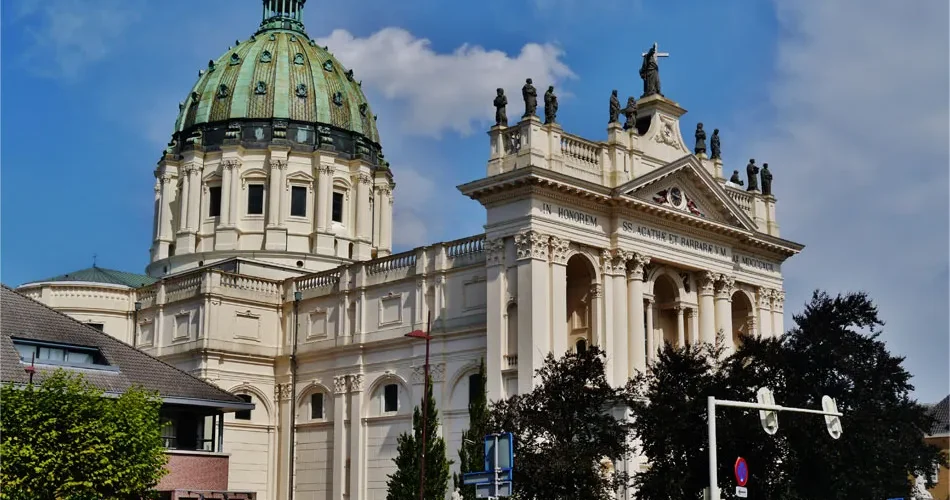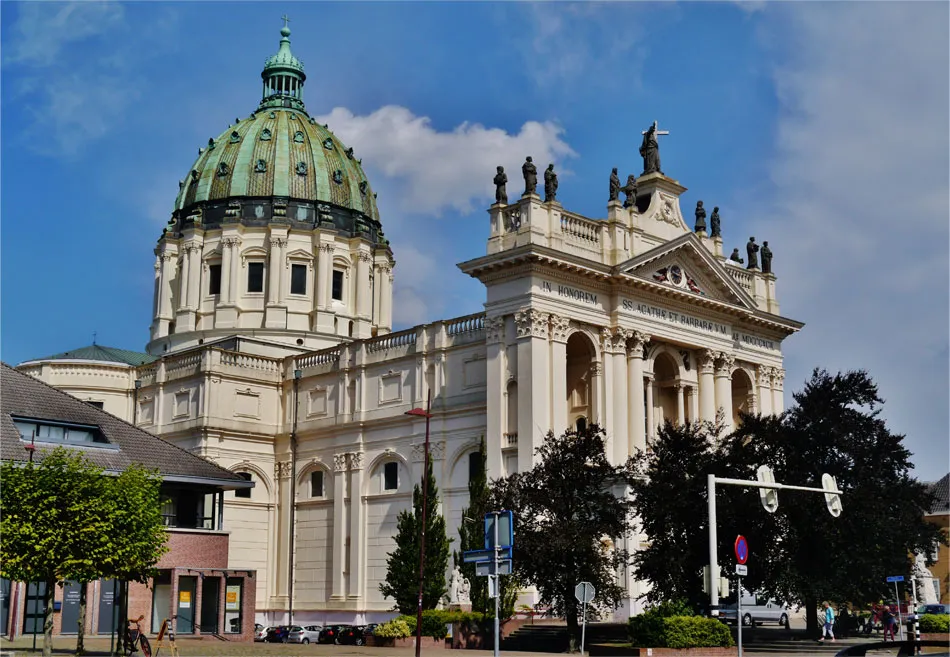
Introduction
The Agatha and Barbara Basilica in Oudenbosch is a Roman-Catholic church in the province of Noord- Brabant. This beautiful church in The Netherlands is a small version, and copy, of the St. Peter in Rome. The architects of this version are P.J.H. Cuypers and G.J. van Swaay. Both the inside and outside are heavily copied from the St. Peter in Rome. Even pieces from the Sistine Chapel are found in the small domes in this basilica in The Netherlands. It’s named after the two female saints: Agatha and Barbara. The church of Oudenbosch was named the St. Agathakerk before the basilica in this town was built. Agatha was one of the first saints in the Catholic church. Barbara was one of the early saints of the Catholic church as well.
The Oudenbosch Basilica is a Roman Catholic basilica in the Dutch village of Oudenbosch. The basilica is named after Agatha of Sicily and Barbara of Nicomedia, two Christian martyrs from the third century. It was built at the initiative of Willem Hellemons who was parish priest between 1842 and 1884. Its nave and interior were modeled after St. Peter’s Basilica, while the facade is a replica of the Basilica of St. John Lateran, both located in Rome. The basilica was designed by architect Pierre Cuypers. Construction began in 1865 but was not fully completed until 1892. The basilica is unique in the region in that it is relatively large with a classical Italian appearance that is atypical for most of northern Europe, let alone a small town in North Brabant.
Dutch Papal Zouaves and local Catholics gathered in Oudenbosch and left for Rome in 1868 to defend the Papal State against Giuseppe Garibaldi’s Italian nationalist army. Therefore Pope Pius IX agreed to build a relatively big basilica in a small place. Originally a church, it was designated a minor basilica in 1912. A piece of the cloak Pope John Paul II wore during the 1981 assassination attempt is kept there as a relic. Elements inspired by their counterparts in Rome include Michelangelo’s Pietà, Bernini’s baldachin, the Chair of Saint Peter, and Bernini’s Gloria.
Priest Willem Hellemons gave orders to built this church as a replacement of the gothic church of Oudenbosch. This priest had studied in Rome as was blown away by the architecture. When you visit this basilica in Noord- Brabant you will be mesmerised by the endless ceiling frescoes and statues. What I would recommend you to do, when you visit the highlight of Oudenbosch, is to take your time. It’s a big basilica, so enjoy it by taking it all in. The basilica in Oudenbosch is free to visit, and for a little extra, you can walk up to the dome of this church on Noord- Brabant.
THERE ARE SEVERAL THINGS THAT will strike you as strange about this Dutch replica of Saint Peter’s Cathedral in Oudenbosch. First, it is a monumental piece of neo-classical architecture in a country that has almost none. Its designer, Petrus Cuypers, was a legendary Dutch architect who built the Rijksmuseum and the Central Station in Amsterdam, both of which have come to symbolize Dutch architecture–but this structure is an aesthetic anomaly, both for Cuypers and for Northern Europe.
Built in the late 19th century by a Dutch friar, this Cathedral is a monument to Dutch Catholic’s loyalty during the attack on the Vatican by Garibaldi in the 1860s. During that period, about 3000 Dutch Catholics (Zouaves) went to Rome to protect the Papal State. Inspired by St. Peter’s Cathedral, friar Willem Hellemons summoned the famous Cuypers (who was also a Roman Catholic) to build a replica in Oudenbosch to replace the old church, which was in very bad shape. Construction began in 1865 and the basilica was finished in 1912. Down to the very paintings on the inside of the dome, the basilica makes an effort to copy St. Peter’s.
While the height of the church is not even half that of Saint Peter’s in the Vatican, and the internal space is 1/16 that of the larger church, but it is still quite impressive, especially given its unexpected location in a small town in the Netherlands. From afar you can see the dome of the Oudenbosch Basilica in the landscape so typical for this part of Brabant. But when you’re getting closer to the Basilica it gets more and more impressive. With a length of 81 meters, a width of 55 meters and a heigth of 63 meters, this Basilica is a scaled copy of St Peters Basilica in Rome.
The Oudenbosch Basilica wasn’t a Basilica up to 1912. During a special service in 1912, the church received the title Basilica Minor. A church receives this title because of its history, beauty or relics in place. It’s not the history or relics, but it’s special story together with the relation of the Basilica with Rome which gives this church the right to be called a Basilica Minor.
Construction of the Basilica of Oudenbosch started in 1865 and the church was elevated to a basilica in 1912. The end of the restoration (1954-1987) actually only meant the completion of this impressive building. The architects of the Basilica are P.J.H. Cuypers and G.J. from Swaay. The architect Cuypers is best known for the construction of the Rijksmuseum. He has designed more historic buildings within the municipality of Halderberge. Hotel and Monastery Bovenbonk is an impressive example of this! The building pastor of the Basilica is W. Hellemons. Pastor Hellemons studied in Rome and was a great admirer of the Roman architectural style. That is why he chose St. Peter’s as an example for a new church to be built in Oudenbosch and the front of the Basilica of St. John Lateran as a model for the facade. Since its completion in 1892, the basilica has a length of 81 meters, width of 55 meters and the highest point is the dome, which is 63 meters. A volume that is 16 times smaller than St. Peter’s in Rome.
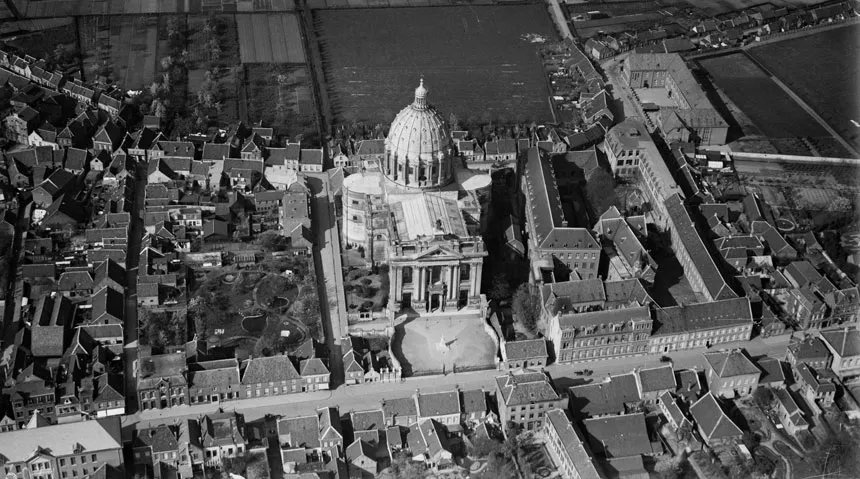
Origin of Oudenbosch
In the year 1275, the lord of Breda gifts the grounds of Baerlebosch and Gastele to the Abbey of Hemiksem. These wild grounds with swamps needs cultivation. The monks and brothers start with their work. Through the years, Baerlebosch becomes a trading town for peat. After the Elizabethsflood, which kills thousands in the southwestern part of the Netherlands, Baerlebosch becomes Oudenbosch. In 1425, just 4 years after the Elizabethsflood, a new church, the Agatha church is built. This church will dominate the Oudenbosch’ skyline until the 19th century, when the Oudenbosch Basilica is built.
In 1865 the construction starts, but years of planning and designing precedes. Willem Hellemons asks the famous dutch architect Petrus (Pierre) Cuypers to design and build this new parish church. Cuypers, a neogothic architect, prefers a neogothic church over a neoclassicistic church, but Hellemons is persistent, and Cuypers travels to Rome for research. After permission being granted by the bisshop, the construction starts. It takes 15 years, until 1880 to build the churches nave. But this doesn’t mean the church is completed. The contrary.
After completion of the nave, two other projects start. The churches front and the decoration still need a lot of work. The front is a partial copy of Saint John Lateran and decoration will be the biggest task to be done. In 1892, the churches front is completed by G.J. van Swaay. At that time, decoration isn’t even halfway completed. It would take Kiske Raaijmakers until the ’30 to complete decoration together with his team. Inhabitants saw a work of art changing day by day, every day closer to completion The Oudenbosch Basilica was built during a time where lots of Zouaves, the voluntary army for the Pope, traveled to Rome through Oudenbosch. The Basilica was built in honour of those men. With construction almost completed, a monument, remembering the Zouaves was unveiled in front of the Basilica.
- The name Oudenbosch was originally called Oud Baerlebosch. This referred to the nearby creek called Barlaecke. As time went by, Oud Baerlebosch changed into Oudenbosch. In 1275, Arnoud van Leuven and his wife Elisabeth gave the Baerlebosch and a lot of swampy land to an abbey in Hemiksem. The monks of the monastery extracted the area from peat, and a small canal was dug around the 1300s.
- Oudenbosch belonged to the city of Bergen op Zoom from 1287; this turned into the marquisate of Bergen op Zoom in 1533. Oudenbosch was the capital city of the eastern part of the marquisate of Bergen op Zoom. The important men of Bergen op Zoom gave Oudenbosch several privileges, such as the right for a weekly market. This helped to develop the town. Plus there was a ferry from Oudenbosch to the important trading city of Dordrecht, which also was very useful for further developments. Oudenbosch soon became an important city for trading routes from Antwerp to Bergen op Zoom.
- During the 80-year-war Oudenbosch was plundered by the Sea Beggars. But that’s not all. From 1604-1605, the plague was taking over Oudenbosch, and almost all the inhabitants died. In 1625, another plague epidemic made its way to Oudenbosch. After the French occupation was finished, the local economy became a bit better.
- The city of Oudenbosch is located on soil that has sand and marine clay, which turned out to be very fertile for tree nurseries. Oudenbosch served as a depot for Catholics that were fighting on the side of Pope Pius IX. They could stay in Instituut Saint- Louis and got their first training in Oudenbosch.
- Because Oudenbosch was a spiritually important town, a new church with a dome was built. It was inspired by the St. Peters Basilica in Rome but is a tad smaller. Construction started in 1865, and it was finished in the 1880s.
- Oudenbosch had a relatively easy time during the Second World War. There were no bombings, massive destructions or deaths. The only thing was that the economic crisis made everything a lot harder. Oudenbosch was freed from the Germans on the 30th of October 1944.
Architecture of Oudenbosch Basilica, Oudenbosch Netherlands
Architect: Dr. P. Cuypers, G.J. van Swaay
Architectural styles: Neoclassical architecture
The Oudenbosch Basilica has great interior resemblance with it’s inspiration the St. Peter’s Basilica. From the sacramental altar and canopy to the nave and dome, the details are amazing, thanks to architect Pierre Cuypers who designed the Oudenbosch Basilica and the craftsmen who were responsible for decoration.
Oudenbosch Basilica is a Roman Catholic church located in Oudenbosch in the province of Noord-Brabant, Netherlands. The building was constructed between 1759 and 1787 and is a popular pilgrimage site. The imposing baroque building consists of a three-aisled transept and a three-aisled sanctuary. The central altar is decorated with a painting of the assumption of Maria and the high alter is devoted to St. Sebastian. The church’s main entrance is surrounded by two towers, each containing a bell. Inside, seventeen side chapels line the walls of the main nave, each containing a painting or sculpture. The stained-glass windows and the church’s rich decoration are highlights for visitors, as well as its high altar and elaborate choir stalls. The bells in its high towers can be heard from miles away. The basilica itself is huge, 81 meters long, 55 meters wide and the height of the dome is 63 metres. However not everything is as it first appears, the wealth of marble is in fact on closer inspection ‘only’ painted wood – however it is none the less beautiful for these frugal adjustments, if anything it makes it even a bit more impressive. It is well worth the visit for those seeking spiritual retreat and those who appreciate its beauty.
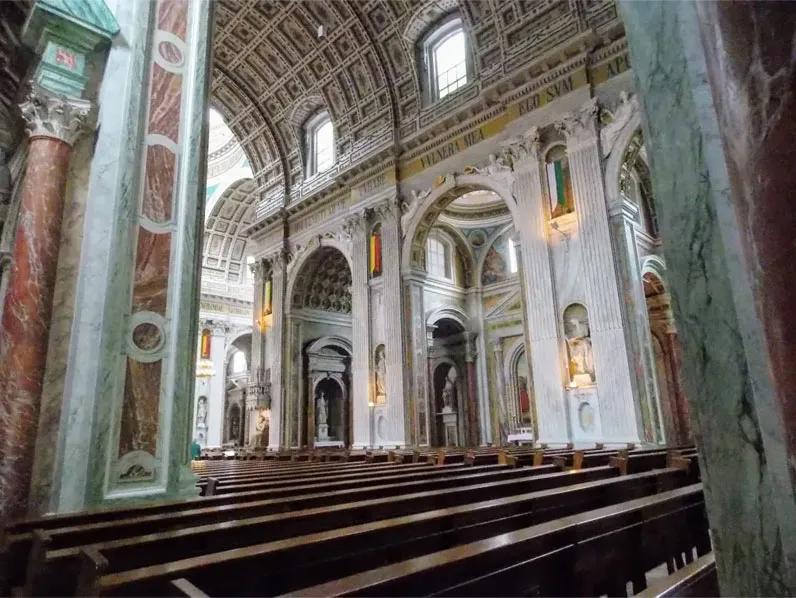
Most beautiful monuments in Oudenbosch
- At Markt 32-34 you can find Chapel Saint Louis, which is the former boarding school of the Broeders van Oudenbosch.
- At Markt 42-44 you will see a beautiful postal office that dates back to 1899.
- At Markt 61, you can spot the former Sint-Anna monastery which was founded in 1837, but currently, the oldest building is from 1890.
- At Markt 66-68, you will discover a former college for Jesuits.
- At Fenkelstraat 24, you can find a simple church built in neoclassical style in 1819.
- At Fenkelstraat 26, you will see a presbytery which dates back to 1562, but it was renovated in 1632 and revamped in the 19th century.
- At Markt 31, you will discover the former town hall of Oudenbosch which dates back to 1776. It was the town hall until 1972.
- At Jezuïetenplein 3, you can find the former Jesuits monastery. Nowadays an observatory is located here.
Heritage and history of Oudenbosch
The Oudenbosch Basilica is an important part of the history of Oudenbosch. The Basilica is a result of the growing catholicism in Noord-Brabant. Around the Basilica you will find a lot of heritage worth visiting such as the former boys school St. Louis, Tivoli Observatory and Botanical Garden Arboretum. During a city walk in Oudenbosch a guide will tell you more about the history.
In stark contrast to its early medieval roots, the church is adorned with a Baroque facade that demands attention and serves as a grand welcome to families exploring the site. Introduced in the 17th century, its striking red facade is a visual spectacle, drawing visitors into the church’s equally rich Baroque interior. The interior is marked by exquisite Baroque chapels, including the renowned Chapel of St. John of Nepomuk, adorned with art and symbols of the sanctity and history it represents. Children may be fascinated by the elaborate designs and the stories depicted within the chapels’ frescoes, providing a visual feast that narrates tales of saints and patrons. This historical gem also features a charming Baroque portico, an inviting entrance flanked by artistic sculptures and embellishments that speak volumes of the era’s exquisite style and the skill of its architects. Its Baroque elements create a warm and lavish atmosphere that envelops families in the rich tapestry of Prague’s architectural heritage.
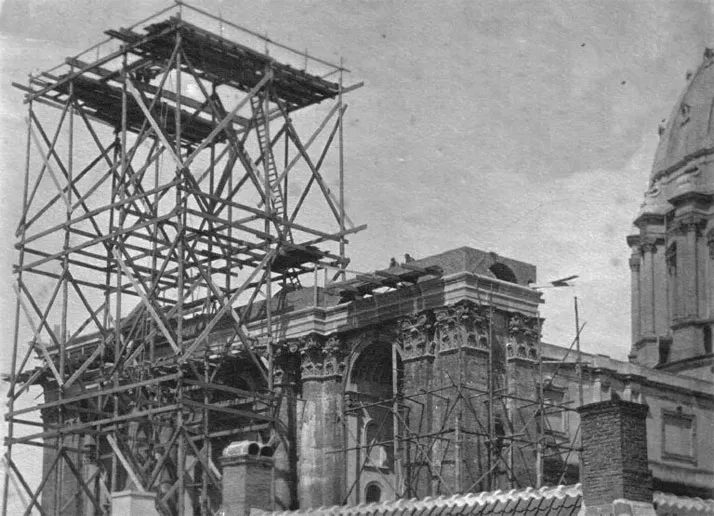
Zouave monument placed
The Basilica of Oudenbosch was built at a time when many Zouaves, fighters for the Pope in Italy, travelled via Oudenbosch to Rome from all over the Netherlands. The Basilica was built in honour of the Zouaves. With the construction of the Basilica in the final phase, the Zouave Monument was placed on the square in front of the church.
Church is dedicated Basilica Minor
The Basilica of Oudenbosch has not always been a Basilica. That happened with a solemn service in 1912. A church is given the honorary title of Basilica if a church has a venerable age, considerable size or special beauty. The Basilica of Oudenbosch is not particularly old or large in size, but its beauty, as well as its special connection with Rome and the Basilicas there, have made the church of Oudenbosch elevated to Basilica.
Hellemons becomes pastor
The young priest Willem Hellemons arrives in Oudenbosch after his priest studies in Rome. When he becomes the new pastor, he is only 32 years old and filled with ambition. During his studies in Rome, he gets inspired by the impressive catholic basilicas such as the St Peter and Saint John of Lateran. When he starts as a pastor, he soon notices the old Agatha church is too small for the fast growing number of catholics in Oudenbosch.
The Basilica of Oudenbosch as a sight
There is a special atmosphere in the Basilica of Oudenbosch, it is anything but an ordinary church. The detailed facade modeled on St. John Lateran with its beautiful sculptures, details and high arches invites you to visit. Upon entering you really see how immense the Basilica is, the high ceilings, marble columns and of course the impressive dome create the feeling that you have not entered an ordinary church. A highlight of the Oudenbosch basilica is certainly the apse, the semicircular part behind the altar. This beautifully designed elevation in the Basilica with a beautiful stained glass window has stopped many visitors in their tracks. The literal highlight of the Oudenbosch basilica is the dome. This can be accessed via a 140-step spiral staircase. Even before you enter the Basilica you will pass a special statue. This statue tells the story about the Dutch Zouaves. A stone’s throw from the Basilica you will find the Dutch Zouaves Museum, where you can learn more about this special volunteer army that went to Rome for the Pope.
The Basilica and other copies of St. Peter's
1. Basilica Major di San Pietro, Rome
The seat of the Pope in Rome in Vatican City. St. Peter’s is not originally the archbasilica of Rome, that is St. John Lateran. St. Peter’s is characterized by its dome and curved colonnades around St. Peter’s Square. The tombs under the Basilica house the graves of the Catholic Popes. Bernini’s baldachin is also one of the important highlights in St. Peter’s.
2. Basilica of Our Lady of Peace, Yamoussoukro, Ivory Coast
Surreal, that is the best word to describe this basilica in the capital of Ivory Coast. Built between 1985 and 1989, this is a relatively young basilica that was elevated to basilica in 1990, only a year after completion.The most striking feature of this church is the dome. It is no less than 90 metres in diameter, while the dome of St. Peter’s is 42.6 metres.
3. Mary, Queen of the world, Montreal, Canada
Perhaps the most faithful is the Mary Queen of the World in Montreal. Where other churches often copied similarities or parts of the church, this church shows many similarities, from the facade to the dome and decorations. This Basilica was also built during the struggle between the papal state and the rest of Italy. From Canada, over 500 Zouaves travelled to Rome to fight for the Pope. Just like in the Basilica in Oudenbosch, the fallen Zouaves are honoured with a plaque.
4. Basilica dell’Incoronata Madre del Buon Consiglio, Naples, Italy
The Basilica of the Crowned Mother of Good Counsel in Naples is also called “Little St. Peter” in Italy and not without reason, the resemblance is striking. The Basilica is a lot smaller than its big brother in Rome, but is certainly worth a visit.
5. Basilica of Saints Agatha and Barbara, Oudenbosch, Netherlands
The Basilica of Oudenbosch may well have the most similarities with St. Peter’s, when it comes to the interior. From sacramental altar to canopy and from nave to dome, the similarities are sometimes almost unbelievable, but that is due to the careful preparation and the great detail with which architect Pierre Cuypers and later the craftsmen who were responsible for the decoration, went to work.
Annual Feast Day
Feast day: Saint Agatha: February 5th
Saint Barbara: December 4th
The annual feast day of The Church of Basilica of the HH Agatha and Barbara in Oudenbosch, Netherlands is celebrated on (February 5th for Saint Agatha and December 4th for Saint Barbara) each year.
Mass Timing
Monday to Saturday
10:00 – 04:30 Pm
Sunday
10:00 – 04:30 Pm
11:00 Am Eucharistic Celebration
Contact Info
Markt 57,
4731 HN,
Oudenbosch,
Netherlands
Phone No.
Tel : +316 – 222 19 080
Tel : +31 165 330 502
Accommodations
Connectivities
Airway
The nearest airport to The Church of Basilica of the HH Agatha and Barbara in Oudenbosch, Netherlands is, Breda International Airport, Pastoor van Breugelstraat 93, 4744 RC Bosschenhoofd, Netherlands which is just 11 min (5.2 km) via Vaartweg and Pastoor van Breugelstraat away from the basilica.
Railway
The nearest railway to The Church of Basilica of the HH Agatha and Barbara in Oudenbosch, Netherlands, Roosendaal, 4702 VX Roosendaal, Netherlands which is just 14 min (11.1 km) via A58 away from the basilica.

